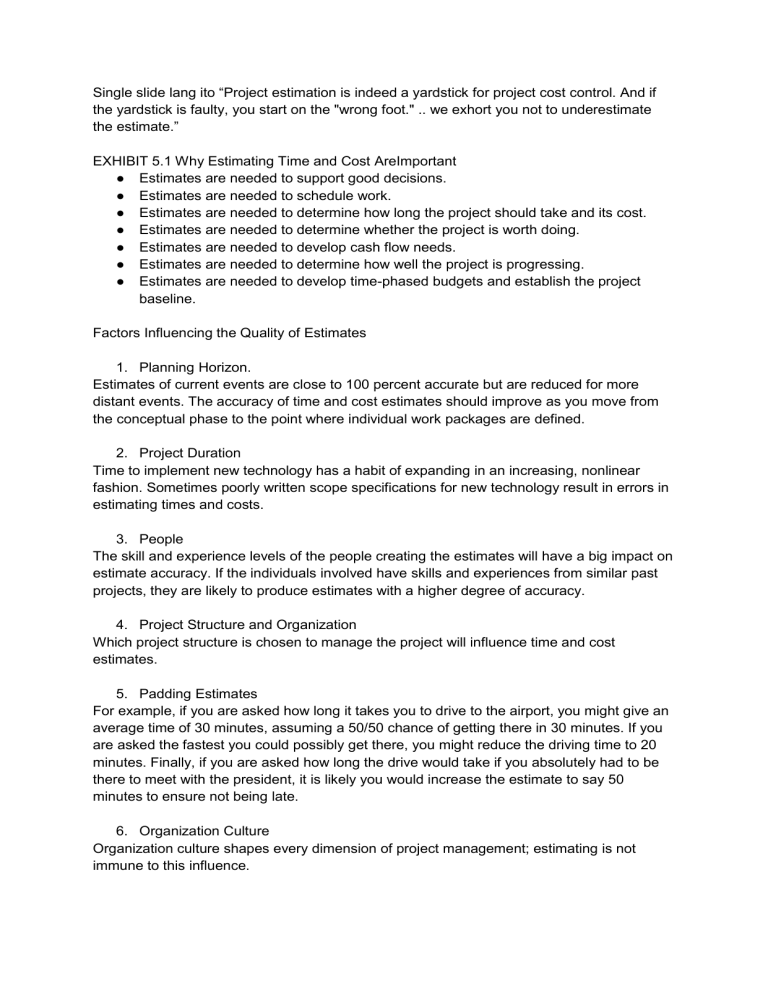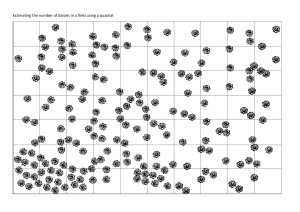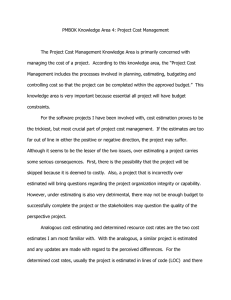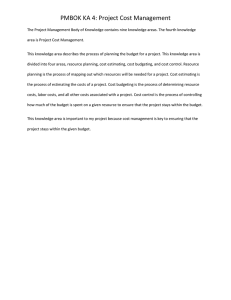
Single slide lang ito “Project estimation is indeed a yardstick for project cost control. And if the yardstick is faulty, you start on the "wrong foot." .. we exhort you not to underestimate the estimate.” EXHIBIT 5.1 Why Estimating Time and Cost AreImportant ● Estimates are needed to support good decisions. ● Estimates are needed to schedule work. ● Estimates are needed to determine how long the project should take and its cost. ● Estimates are needed to determine whether the project is worth doing. ● Estimates are needed to develop cash flow needs. ● Estimates are needed to determine how well the project is progressing. ● Estimates are needed to develop time-phased budgets and establish the project baseline. Factors Influencing the Quality of Estimates 1. Planning Horizon. Estimates of current events are close to 100 percent accurate but are reduced for more distant events. The accuracy of time and cost estimates should improve as you move from the conceptual phase to the point where individual work packages are defined. 2. Project Duration Time to implement new technology has a habit of expanding in an increasing, nonlinear fashion. Sometimes poorly written scope specifications for new technology result in errors in estimating times and costs. 3. People The skill and experience levels of the people creating the estimates will have a big impact on estimate accuracy. If the individuals involved have skills and experiences from similar past projects, they are likely to produce estimates with a higher degree of accuracy. 4. Project Structure and Organization Which project structure is chosen to manage the project will influence time and cost estimates. 5. Padding Estimates For example, if you are asked how long it takes you to drive to the airport, you might give an average time of 30 minutes, assuming a 50/50 chance of getting there in 30 minutes. If you are asked the fastest you could possibly get there, you might reduce the driving time to 20 minutes. Finally, if you are asked how long the drive would take if you absolutely had to be there to meet with the president, it is likely you would increase the estimate to say 50 minutes to ensure not being late. 6. Organization Culture Organization culture shapes every dimension of project management; estimating is not immune to this influence. 7. Other Factors Nonproject factors can impact time and cost estimates. For example, equip. ment down-time can alter time estimates. National holidays, vacations, and legal limits can influence project estimates. Project priority can influence resource as-signment and impact time and cost. Estimating Guidelines for Times, Costs, and Resources 1. Responsibility. At the work package level, estimates should be made by the person(s) most familiar with the task. Those responsible for getting the job done on schedule and within budget are usually first-line supervisors or technicians who are experienced and familiar with the type of work involved. 2. Use several people to estimate People bring differ-ent biases based on their experience. But discussion of the individual differences in their estimate leads to consensus and tends to eliminate extreme estimate errors. 3. Normal conditions Estimates should be based on normal conditions, efficient methods, and a normal level of resources. Normal conditions are sometimes difficult to discern, but it is necessary to have a consensus in the organi-zation as to what normal conditions mean in this project. 4. Time units Specific time units to use should be selected early in the development phase of the project network. All task time estimates need consistent time units. Estimates of time must consider whether normal time is represented by calendar days, workdays, workweeks, person days, single shift, hours, minutes, etc. 5. Independence. Estimators should treat each task as independent of other tasks that might be integrated by the WBS. 6. Contingencies Work package estimates should not include allowances for contingencies. The estimate should assume normal or average conditions even though every work package will not materialize as planned. For this reason top management needs to create an extra fund for contingencies that can be used to cover unforeseen events. 7. Adding risk assessment to the estimate helps to avoid surprises to stakeholders. For example, a new technology usually carries more time and cost risks than a proven process. Simply identifying the degree of risk lets stakeholders consider alternative methods and alter process decisions. Top-Down versus Bottom-Up Estimating Table 5.1 depicts conditions that suggest when one approach is preferred over another. Top Down estimates usually are derived from someone who uses experience and/or information to determine the project duration and total cost. These estimates are sometimes made by top managers who have very little knowledge of the processes used to complete the project. Methods for Estimating Project, Time and Costs Consensus Methods This method simply uses the pooled experience of senior and/or middle managers to estimate the total project duration and cost. This typically involves a meeting where experts discuss, argue, and ultimately reach a decision as to their best guess estimate. Ratio Methods Top Down estimates (sometimes called parametric) usually use ratios, or surrogates, to estimate project times or costs. Top Down estimates are often used in the concept or “need” phase of a project to get an initial duration and cost estimate for the project.






